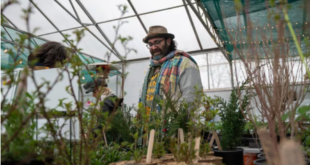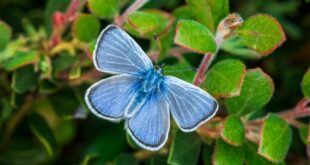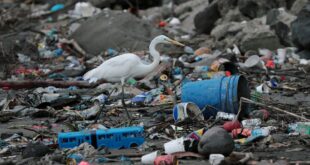‘They are going to go extinct, it’s almost certain,’ Alberta ecologist warns.

The greater sage grouse, which once numbered in the thousands in Western Canada, is coming perilously close to vanishing from the Prairies, new government research shows.
Known for its unusual mating dance, the species — found in areas where sagebrush grows — has been in trouble for decades.
The round-bodied bird is among the species most at risk in Canada. The latest data from government conservationists provides little hope for their future.
Mark Boyce, a University of Alberta ecology professor and Alberta Conservation Association endowed chair in fisheries and wildlife, said populations are on the brink.
“It’s desperate,” said Boyce, who has researched sage grouse for decades.
“They are going to go extinct, it’s almost certain.”
Sage grouse once numbered in the thousands in Canada, if not the hundreds of thousands, with a sweeping range of 100,000 square kilometres.
Today, there are fewer than 100 in Canada. Their range in southeast Alberta and southwest Saskatchewan has shrunk to less than 10 per cent of what it once was.
An Alberta government census published last month showed only 45 sage grouse are believed to remain in the province. Last year’s spring count recorded 17 males, down from the 22 counted in 2022.
Only three of Alberta’s 38 known lek sites — critical mating grounds for the species —remain active, according to the provincial report.
In southern Saskatchewan’s Grasslands National Park, only 24 males were spotted during the 2023 spring count at the only remaining leks in the province.
Boyce said the sage grouse is especially vulnerable as Western Canada braces for a summer drought that will further damage grazing lands that are critical habitat.
“We can’t sustain a population that small, especially given climate change effects,” he said.
“We’ll probably lose them this year.”
Gathering detailed census data on the endangered species has long proved a challenge. Population estimates are based on the number of males counted on the leks, expanses of open prairie where the birds gather each spring to find mates.
For the most recent Alberta count, government researchers visited each lek three times, watching with binoculars to count the chubby, large-chested males as they arrived on the dancing grounds.
Strutting their stuff
The spring mating ritual is a spectacle that has made the birds beloved among biologists and birdwatchers.
Males, with the dappled brown feathers of their starburst tails on full display, gather at leks and begin their dances at sunrise — strutting, posing and thrusting their beaks.
Yellow sacks on their chests fill with air and then deflate, creating a burbling sound before the birds do a distinctive swish of their wings.
“A female will show up and she’ll wander through the lek and and it’s literally like she’s checking these guys out,” Boyce said.
“The males will do it again and again, and the ones that strut most vigorously are the ones that the female will choose.”
It’s ladies’ choice, as hens line up for the chosen male, he said.
“It gets fast and furious.”

Watch these birds in Alberta perform a synchronized dance routine to attract a mate
Watch Secret World of Sound on CBC Gem.
Habitat loss caused by industrial development has posed the biggest threat to the species, Boyce said. Unlike other birds that can thrive around humans, the sage grouse is especially fragile to any kind of disturbance.
Noise caused by pumpjacks or nearby roads, or the construction of fencing or power lines, can all cause the birds to abandon the area.
Endangered for decades
The species has been listed as endangered in Canada since 1998. It was designated an endangered species in Saskatchewan in 1999. Alberta followed suit the following year.
But numbers have continued to wane, and in 2013, in response to a court challenge, Ottawa introduced an emergency protection order for the species.
In an effort to halt further destruction of sage grouse habitat, the protection order imposed strict restrictions on provincial and Crown lands where the birds are found.
Boyce said the order was critical, but more must be done to preserve the few viable sagebrush habitats that remain.
“We’ve already done so much damage to sage grouse habitat that it’s going to be really, really tough to bring them back. It’s an almost hopeless situation.”

Joel Nicholson, a senior wildlife biologist with Alberta Environment, said while sage grouse are extremely vulnerable, he remains hopeful that conservation efforts will succeed.
Alberta researchers are working with landowners, industry and scientists across the Canada-U.S. border to help bolster existing populations, Nicholson said.
The work includes reclamation efforts on privately-owned grazing lands, a seed program that will ensure sagebrush is planted on abandoned oil sites, and introducing new birds into the wild.
Around 40 hens from Montana, equipped with GPS trackers, will be released in Alberta this spring in an attempt to bolster the population.
“It is severe but we do have a lot on the go to try to turn the situation around,” Nicholson said.
“I really hope that we are successful in keeping them in Alberta and it won’t be for lack of trying if we did lose them.”
Miles Anderson’s ranch, south of Fir Mountain in southern Saskatchewan, is among the last places sage grouse can be found in the province.
One lek sits on a fenceline that borders Grasslands National Park. Anderson, who has helped government conservation efforts for years, said collaboration between scientists and landowners must continue.
Sage grouse are a linchpin of the grassland ecosystem, an endangered habitat that should be deeply valued, and something irreplaceable will be lost if their annual dance ends, Anderson said.
“These really biodiverse areas, it’s really important that we try to maintain them.”
ABOUT THE AUTHOR

Reporter
Wallis Snowdon is a journalist with CBC Edmonton focused on bringing stories to the website and the airwaves. Originally from New Brunswick, Wallis has reported in communities across Canada, from Halifax to Fort McMurray. She previously worked as a digital and current affairs producer with CBC Radio in Edmonton. Share your stories with Wallis at wallis.snowdon@cbc.ca.
*****
Credit belongs to : www.cbc.ca
 Atin Ito First Filipino Community Newspaper in Ontario
Atin Ito First Filipino Community Newspaper in Ontario






